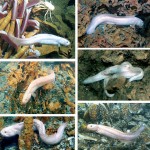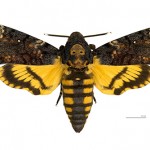by Heather Soulen
Darker Still
Delving deeper into the dark side of taxonomy, we forge forth into the ether to uncover obscure and wickedly inspired scientific names. What’s in a scientific name? As described in The Dark Side of Taxonomy: Part One, some scientific names for organisms have dark and twisted origins. In part two of this three-part series, we peek behind the thin gauze-like veil, fearlessly sifting through time and lore to deliver a new collection of gruesome scientific names. Here we share ancient tales of Greek mythology, an Italian literary genius from the Middle Ages and the unforgiving Underworld.
The Divine Comedy and Greek Mythology
It’s perhaps no surprise that Dante Alighieri’s Divine Comedy oozes with classic Greek mythology. The Inferno and Pergatorio are the first two parts of the three-part epic allegorical poem called the Divine Comedy which describes the living poet’s lengthy journey through hell, purgatory and paradise. In it, Dante references Cerberus, the rivers Styx and Acheron, and Atropos and Lachesis of the Moirai (or the Fates). These are not only characters and locations in Greek mythology, but also scientific names for organisms. Tragic by nature and full of terror, these names conjure feelings of woe, terror and despair. Be warned – what is learned can never be unlearned.
Cerberus, a three-headed watchdog, guards the entrance to the Underworld (Hades), the third circle of Hell in Dante’s Inferno. The pink vent fish (Thermarces cerberus) is aptly named given the extreme and fractured environment in which it lives. Hydrothermal vents are created when cold seawater seeps down into deep fissures in the ocean crust near tectonic subduction zones (places on Earth where two tectonic plates move away or towards one another). It is here that seawater engages in a tumultuous dance with liquid hot magma, percolates up and forms vents that spew hot (340°C/700°F) particle-laden fluids into the ocean above. One could easily imagine this place as some kind of entrance to Hell with the pink vent fish as watchdogs of the Underworld. These fish are found along the East Pacific rise and the Galapagos Rift in the eastern Pacific Ocean. Near the mouth of the Gulf of California pink vent fish were found at depths near 2,300 meters (7,500 feet). The genus Thermarces is derived from the Greek word thermos meaning heat while cerberus refers to the mythological three-headed watchdog that loyally guards the gates of hell.
In both Dante’s Inferno and Greek mythology, Archeron is described as a large and wide river that is full of woe and encircles the entrance the Underworld. The River Styx comprises most of the Fifth Circle of Hell in Dante’s Inferno and is a toxic marsh-like river system meant to punish those who were angry back when they walked amongst the living. It is here that they are doomed to drown in the river’s noxious black fluid over and over for eternity whilst choking on their own venomous rage. In Greek mythology, the river Styx is featured as the boundary between Earth and the Underworld. In Purgatorio, Dante stays true to Greek mythology describing Atropos and Lachesis as two of the three Moirai that control the very fate of every mortal being – Atropos cuts the threads of life of all beings and Lachesis gives the correct amount of life to beings.
The scientific names for three Death’s Head Hawkmoths (Acherontia atropos, Acherontia lachesis, Acherontia styx) all have direct connections with Dante’s poems and Greek mythology, and the genus Acherontia is derived from the Greek word Acheron that refers to that woeful and wide river encircling the Underworld. What’s quite peculiar about hawkmoths is that they share a similar human skull-like pattern on their thorax. Ever watched the movie Silence of the Lambs? It prominently features a Death’s Head Hawkmoth with its characteristic and eerie skull-like pattern.



